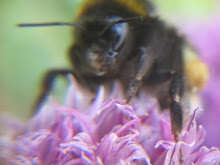skip to main |
skip to sidebar
 It's been a weird coupe of days - even with lots of flowers out there didn't seem as many bees as usual. There is clover, trefoil, thistles and buttercups but it all seemed very quiet - I wonder why that is? It has been very hot: do bees stay in the shade when it's hot?
It's been a weird coupe of days - even with lots of flowers out there didn't seem as many bees as usual. There is clover, trefoil, thistles and buttercups but it all seemed very quiet - I wonder why that is? It has been very hot: do bees stay in the shade when it's hot?
As it goes it was pretty quiet for visitors at YSP too - i reckon everyone was watching the England match at the world cup - maybe that's where all the bees were too.

 At YSP you can fill in a 'bee promise' card (to plant something in your garden that bees like etc) and in return you get a limited edition bee badge with one of my dead bee drawings on.*
At YSP you can fill in a 'bee promise' card (to plant something in your garden that bees like etc) and in return you get a limited edition bee badge with one of my dead bee drawings on.*
On the card you can write where you are from and i thought i should collect all the information and transfer it on to a map of UK to see where all the badges are going. Quite a few don't put where they're from, but the ones that do get represented on the map.
A lot of badges are local / regional to YSP in Yorkshire, but they are going further afield.
The most northern in UK is Haddlington in East Lothian; the most far east is Chelmsford in Essex; and the most far south (and west) is Falmouth in Cornwall. Some have gone international: quite a few to Holland, a couple to Norway and one has gone to La Paz in Bolivia - cool!
*See also Bee Badges posted in March on the blog.

 All the Hawthorn blossom has gone and the Rhododendron flowers are fading, but the bees are now loving the Marsh Thistles Cirsium palustre. They're also loving Creeping Buttercups Ranunculus repens and the big Ox-eye Daisy Leucanthemum vulgare.
All the Hawthorn blossom has gone and the Rhododendron flowers are fading, but the bees are now loving the Marsh Thistles Cirsium palustre. They're also loving Creeping Buttercups Ranunculus repens and the big Ox-eye Daisy Leucanthemum vulgare.
Pictured here are the thistles - my net finally arrived so i spent the other day catching bees and crawling about in thistles, which isn't that comfy. But it was gloriously hot and sunny so i managed to put up with it.
 I took over 500 shots during my last visit to
I took over 500 shots during my last visit to YSP
.
The ones I like the most were taken inside the hive. They are dark and claustrophobic, ambiguous and a bit creepy.
I've put a few more images on my website too.

 A while ago i met a forensic entomologist (like you do)*, and he invited me to look at bees under the microscopes at the Uni near me in Preston. So yesterday i took along my little collection of dead bees that i've been gathering for a while.I entered a magical, mesmerising world inspecting these creatures in so much detail. The complexity of their eyes, the hair magnified, the breathtaking beauty of the wings and the individual grains of pollen collected on their legs. One of my dead bees had its sting out - in close up a gorgeous vicious weapon. I feel that i don't have the capacity of describing the visions in words.I tried unsuccessfully to take photos down the lens, but Adam mentioned they do have a camera that can capture the images and i can use it next time. Really can't wait for the next visit.* Forensic entomologist - someone who works with a highly trained team of insects to detect crime.
A while ago i met a forensic entomologist (like you do)*, and he invited me to look at bees under the microscopes at the Uni near me in Preston. So yesterday i took along my little collection of dead bees that i've been gathering for a while.I entered a magical, mesmerising world inspecting these creatures in so much detail. The complexity of their eyes, the hair magnified, the breathtaking beauty of the wings and the individual grains of pollen collected on their legs. One of my dead bees had its sting out - in close up a gorgeous vicious weapon. I feel that i don't have the capacity of describing the visions in words.I tried unsuccessfully to take photos down the lens, but Adam mentioned they do have a camera that can capture the images and i can use it next time. Really can't wait for the next visit.* Forensic entomologist - someone who works with a highly trained team of insects to detect crime.































